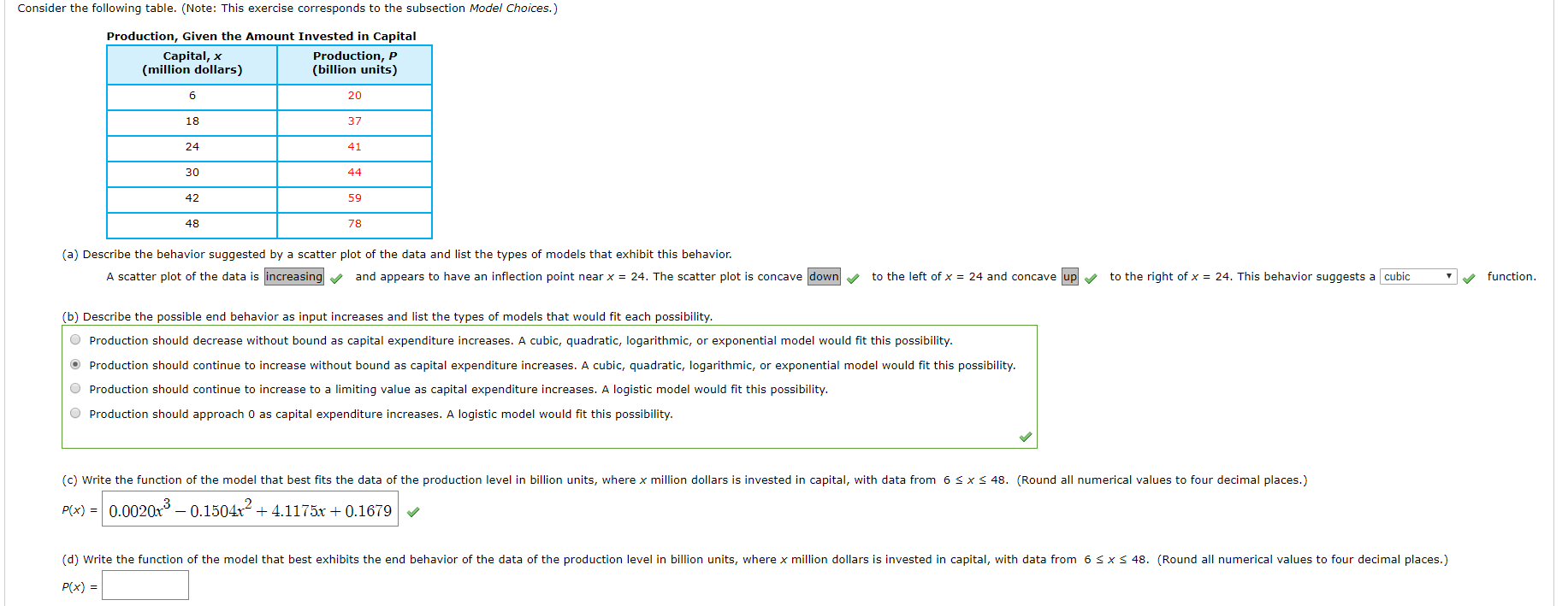Consider the following table. (Note: This exercise corresponds to the subsection Model Choices.) Production, Given the Amount Invested in Capital Capital, x (million dollars) Production, P (billion units) 6 20 18 37 24 41 30 44 42 59 48 78 (a) Describe the behavior suggested by a scatter plot of the data and list the types of models that exhibit this behavior. A scatter plot of the data is increasing to the left of x 24 and concave up and appears to have an inflection point near x = 24. The scatter plot is concave down to the right of x = 24. This behavior suggests a cubic function (b) Describe the possible end behavior as input increases and list the types of models that would fit each possibility. Production should decrease without bound as capital expenditure increases. A cubic, quadratic, logarithmic, or exponential model would fit this possibility Production should continue to increase without bound as capital expenditure increases. A cubic, quadratic, logarithmic, or exponential model would fit this possibility. would fit this possibility. Production should continue to increase to a limiting value as capital expenditure increases. A logistic Production should approach 0 as capital expenditure increases. A logistic model would fit this possibility. (c) Write the function of the model that best fits the data of the production level in billion units, where x million dollars is invested in capital, with data from 6 S x 48. (Round all numerical values to four decimal places.) P(x) 0.0020x3-0.1504x2 4.1175x0.1679 (d) Write the function of the model that best exhibits the end behavior of the data of the production level in billion units, where x million dollars is invested in capital, with data from 6 s x 48. (Round all numerical values to four decimal places.) P(x)
Family of Curves
A family of curves is a group of curves that are each described by a parametrization in which one or more variables are parameters. In general, the parameters have more complexity on the assembly of the curve than an ordinary linear transformation. These families appear commonly in the solution of differential equations. When a constant of integration is added, it is normally modified algebraically until it no longer replicates a plain linear transformation. The order of a differential equation depends on how many uncertain variables appear in the corresponding curve. The order of the differential equation acquired is two if two unknown variables exist in an equation belonging to this family.
XZ Plane
In order to understand XZ plane, it's helpful to understand two-dimensional and three-dimensional spaces. To plot a point on a plane, two numbers are needed, and these two numbers in the plane can be represented as an ordered pair (a,b) where a and b are real numbers and a is the horizontal coordinate and b is the vertical coordinate. This type of plane is called two-dimensional and it contains two perpendicular axes, the horizontal axis, and the vertical axis.
Euclidean Geometry
Geometry is the branch of mathematics that deals with flat surfaces like lines, angles, points, two-dimensional figures, etc. In Euclidean geometry, one studies the geometrical shapes that rely on different theorems and axioms. This (pure mathematics) geometry was introduced by the Greek mathematician Euclid, and that is why it is called Euclidean geometry. Euclid explained this in his book named 'elements'. Euclid's method in Euclidean geometry involves handling a small group of innately captivate axioms and incorporating many of these other propositions. The elements written by Euclid are the fundamentals for the study of geometry from a modern mathematical perspective. Elements comprise Euclidean theories, postulates, axioms, construction, and mathematical proofs of propositions.
Lines and Angles
In a two-dimensional plane, a line is simply a figure that joins two points. Usually, lines are used for presenting objects that are straight in shape and have minimal depth or width.
i am having trouble with d)

Trending now
This is a popular solution!
Step by step
Solved in 5 steps with 5 images






